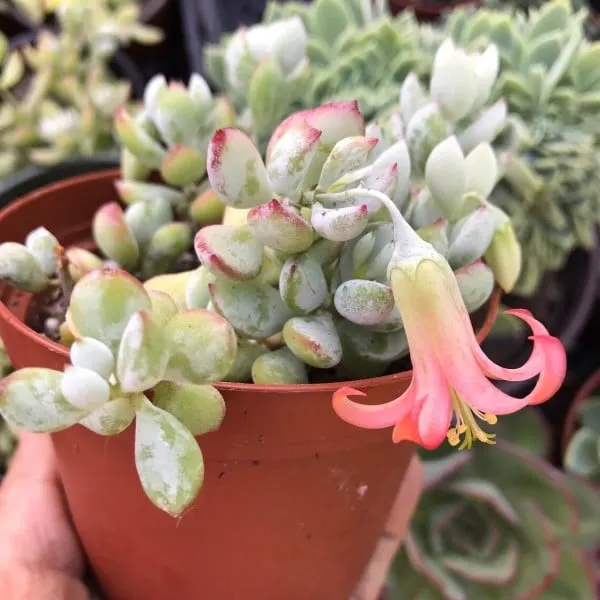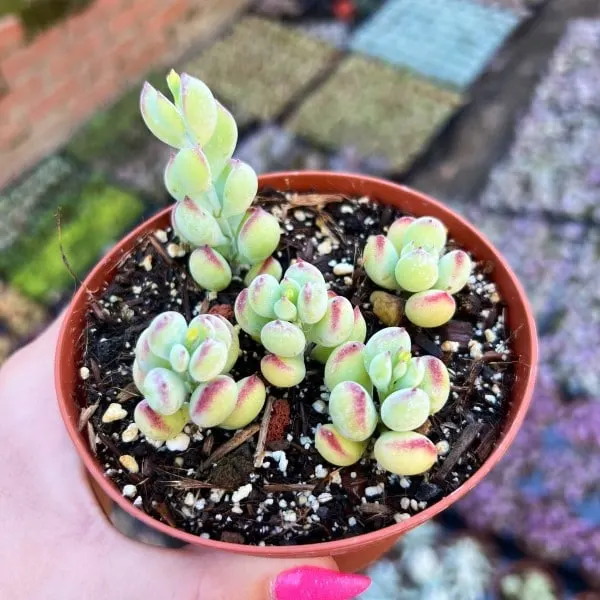The Cotyledon Pendens, also known as the “Cliff Cotyledon,” is a succulent (member of the Crassulaceae family) native to eastern South Africa. In the wild, it exists as a heavily branched shrub with dangling stems that grow as long as 60 centimeters.
This plant is considered pretty low maintenance- the perfect plant for those who want to beautify their home gardens without putting in a lot of effort.

The Main Characteristics of a Cotyledon Pendens plant
Leaves
Many home gardeners seek out the Cotyledon Pendens for its uncommon beauty. The plant sports plump, grey-green leaves alongside white leaves bordered by light red margins.
Flowers
The plant sports bell-like flowers that sport varying red or orange hues. These flowers dangle from the trailing branches of this plant and grow up to 4 centimeters in length depending on how much light and nutrition they’re getting.
Branches
The Cotyledon Pendens stays close to the ground as most shrubs do. Unlike other succulents, though, Pendens are trailing plants that form many complex, tangling branches.
These branches are leafy and can grow up to 2 feet (60cm) in length. Several tiny leaves arranged in opposite pairs cover these branches.
Pests
Cotyledon Pendens are not very susceptible to insect infestation. Although, you may detect a minor mealybug or mite assault on occasion. Rinsing with water and/ or detergent mixture is usually sufficient. If somehow the problem continues, insecticides may be used.
Toxicity
The Cotyledon Pendens are highly attractive and mesmerizing to look at, yet they are harmful to animals. Puppies, cats, and even animals like goats or cows may be harmed by the sap from the plant’s leaves and stems.
Top Caring tips for the Cotyledon Pendens Plant
Watering
Watering is a crucial aspect of this plant’s growth. During warmer seasons, we recommend that you water your Cotyledon Pendens Plant once every 7 to 8 days.
However, you should make sure that you do not go over water this plant since that might cause its roots to rot.
During colder seasons, it is adviced that you reduce the frequency with which you water your plant. Typically, watering your plant every 16 to 20 days should be enough.
Light
These Pendens plants enjoy a decent amount of sunlight and should be kept in places where they’re exposed to bright, full sunlight. Although, you should know that keeping this plant in a place where it gets a bit of shade from time to time is not going to do it any harm.
Temperature & Humidity
Cotyledon Pendens grow well in warmer regions with high sun exposure. The minimum level of humidity that these plants require to grow properly hovers around 40%.
You should know that this plant is not tolerant of frost. So, if you expose it to cold temperatures for prolonged time periods, you will risk killing your plant.
In areas where the temperatures are extremely hot, the Cotyledon Pendens will begin hibernating to preserve water. Hibernation can last up to 3 months, depending on the surrounding temperature.
Soil
For Cotyledon Pendens, you need soil that is extremely well-draining. This quality is important because the Cotyledon Pendens’ roots rot pretty easily if it is kept in waterlogged soil for prolonged time periods.
To prepare your mix, take equal portions of standard potting soil along with sand and mix them thoroughly. Next, mix some compost into your pot and then add a layer of pumice at the base of the pot. This mix will give your plant the proper nutrition and drainage it needs to grow properly.

How to successfully propagate a Cotyledon Pendens indoors
In this section, we will discuss the correct way you can propagate your Cotyledon Pendens plant inside your home. A fair bit of warning, though, you should know that while the propagation for these plants is pretty straightforward, these plants do take a fair chunk of time to grow and establish themselves.
You should know that there are multiple ways to propagate a Cotyledon Pendens indoors. However, for our discussion, we will only consider the most popular method. Namely, this is the offsetting method.
The Procedure
- Begin by taking away an offset of the root’s clustered base.
- Then, pluck out all old leaves. This is because these leaves tend to inhibit the plant’s ability to retain water.
- Soak your cuttings in water for 15 mins before planting them in the soil mix you’ve prepared. Doing this will help your plant propagate faster.
- Next, allow your pot to dry a bit before you water your plant again
- Within a couple of weeks, your new Cotyledon Pendens plant should grow out.
Propagation Via Cuttings
Growing a Cotyledon Pendens is pretty simple if you use a Cotyledon Pendens method. This is especially true since you can take out these cuttings at any time of the year (all growth stages).
Your plant’s propagation should work any time of the year, but the best results will usually come from the time between March and November.
Here are the steps:
- Start by slicing off a piece of a mother Cotyledon Pendens plant’s stem. It is preferable that your cutting comes from the lower section of the plant.
- Next, pluck out all except 3- 4 of the lower leaves from your cuttings.
- In this stage, it is really important to handle your new cutting with care; you do not want to damage any part of the cotyledon’s root system since doing so may result in your propagation process becoming unsuccessful.
- Finally, place this cutting into a suitable soil mix that drains pretty well and then place your plant somewhere that receives ample sunlight.
- You should notice some progress after a couple of weeks. So, be patient and keep following the caring tips we outlined above.
Bottom Line
The Cotyledon Pendens is an extremely beautiful plant with awe-striking foliage and colorful flowers of varying hues. The plant, despite its remarkable beauty, is pretty easy to care for. Hence, making it the perfect choice for anyone who wants to beautify their garden without putting in a lot of time and effort.
If you wish to propagate this plant, the offsetting method and the stem cutting methods are the way to go. Simply follow the steps we’ve laid down for you above, and you will be good to go.
